How We Do It: Developing & Implementing a District-wide Focus on Communication and Core Vocabulary (Part 1)
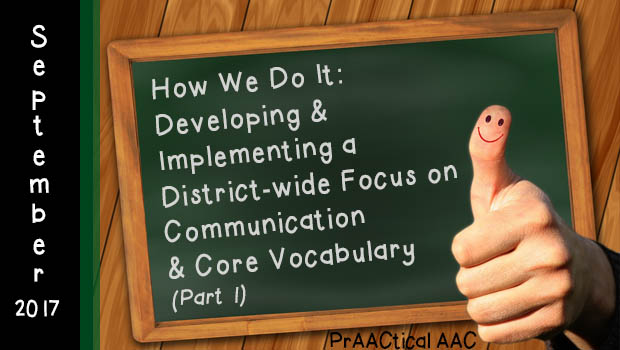
One of the best parts of blogging is getting to connect with talented professionals who are committed to meeting the needs of people who use AAC. In today’s post, SLP Jennifer Ro shares some of the ‘lessons learned’ in implementing a core vocabulary approach to AAC throughout an entire school district.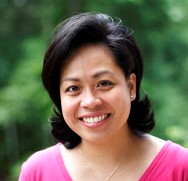 Jennifer is part of the Assistive Technology Team at Forsyth County Schools in Georgia. Focusing much of her 20+ year career in the field of AAC, Jennifer has provided AAC and speech-language services through the public schools, private clinics, early intervention programs, and community-based adult group homes and workshops.
Jennifer is part of the Assistive Technology Team at Forsyth County Schools in Georgia. Focusing much of her 20+ year career in the field of AAC, Jennifer has provided AAC and speech-language services through the public schools, private clinics, early intervention programs, and community-based adult group homes and workshops.
Jennifer helped develop Forsyth’s Core Word Board utilized district-wide. Her current interests include collaborative models of service delivery and staff development in the area of AAC. She has presented at the state and local level with a focus on communication related to AAC, core vocabulary, and language development, social-emotional engagement, visual supports and UDL.
In this post, Jennifer shares some of her top tips for getting started and making it work.
::::::::::::::::::::::::::::::::::::::::::::::::::::::::::
5 Steps and More! Developing, Implementing, and Maintaining a District-wide Focus on Communication and Core Vocabulary (Part 1)
- Just do it. A few inspired people can start it all!
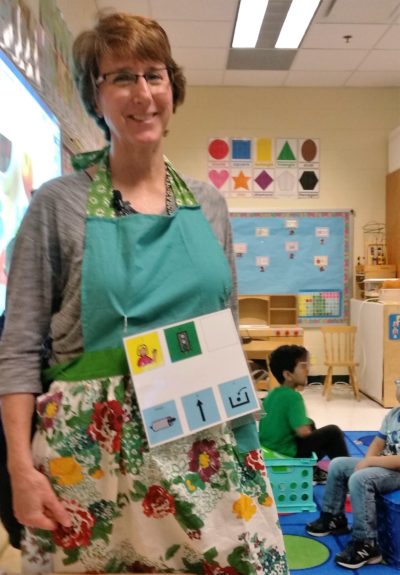
… Identify your most specific needs; the who, the what, and the where.
… Identify the communication and CV materials that will meet the most immediate needs.
… Look at the needs of all staff (including parents). Confirm that the materials can be relevant for all student populations, ages, and developmental levels in your district.
… Develop/determine the CV materials with purpose. Make sure you can articulate the reasons for the elements included. You will get questions!
… Determine what type of training and support will be needed to get started. This will evolve.
… Plant the seeds at every opportunity! At all times, speak with enthusiasm “why” you are doing what you are doing.
It started for me about 10 years ago when I began a new position with Forsyth County Schools. From what I gathered during my first couple of years, every school district struggles with consistent implementation and training for AAC.
Quite simply, there are tremendous needs because the public schools serve students for the long-term. As children get older, natural transitions and changes related to new classrooms, new schools, new staff and the very individual nature of many of our students with limited verbal ability reveal, at times glaringly, the significant challenges of AAC service delivery.
At the time, Forsyth’s Assistive Technology Team had knowledge of core vocabulary thanks to likely one of the earliest trainings on LAMP principles. But what to do about the inconsistencies as students transitioned to new settings and staff? Most obvious to me was the difficulty maintaining students’ previously learned communication skills as they transitioned to new settings or staff.
I wished for a consistent vocabulary large enough for teachers and SLPs to target both comprehension and expression; essentially words that would be relevant and would remain the same regardless of the setting or the topic. 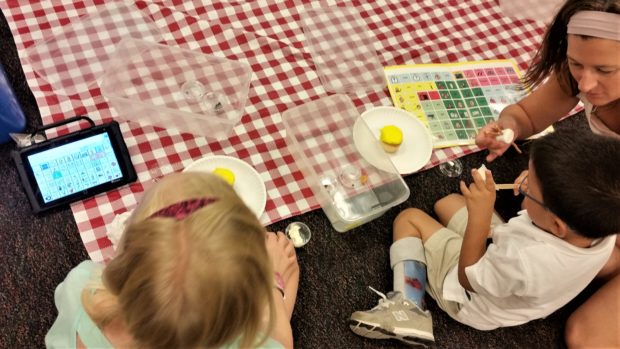
Five years ago, was the turning point. There were just 2 half-time AAC-SLPs on the district’s Assistive Technology (AT) team. Our district was growing, as were the needs.
And we just did it. Really, it became more urgent because of Juanita, a child filled with sunshine and humor, but trapped inside due to a progressive motor disorder.
Juanita had access to AAC devices since she was in early elementary school, but nothing stuck for too long since her motor abilities changed. With a new transition to middle school, we decided Juanita needed a vocabulary to which she would consistently have access, regardless of her motor abilities. And, we decided that it would be low-tech. This, while we continued to meet the AAC device challenges of her progressive motor impairments.
The seeds were planted.
We (myself and Amy Thomsen-Forsyth’s other part-time AAC-SLP) wanted to do it right and for the long-term. We spent several months selecting words and determining layout and sizes for Forsyth’s Core Word Board.
Talking with teachers, SLPs, and parents about what vocabulary and activities that were common and important to them cemented some words and nixed others. We also considered its relevance for PreK through high school and for a variety of purposes: Aided Language Input/modeling, early expression, early writing using simple sentence structures, and enough variety of vocabulary to target various pragmatic functions.
Our jumping off point was informal, very “grass-roots,” if you will. We started at one school that had acquired their first specialized instruction class with students with autism. We knew that they needed a lot of help and they were motivated to receive it. We convinced 3 other schools that year to participate in our CV training and it grew the following years.
We also felt very strongly that if our teachers could effectively develop language and communication skills via CWBs and other low-tech methods, these new teacher skills would readily transfer to developing language and communication with our students who progressed to robust AAC devices.
Initially, the biggest training concept was the consistent availability of the CWB in the classroom and modeling. We knew that if the CWB was not readily accessible, it would not get used.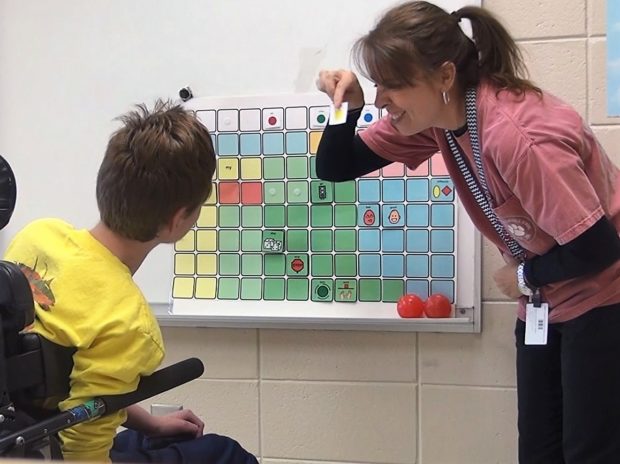
- Focus on its consistent availability in the classroom and the concept that your CV materials are tools for the teacher to teach communication and language in 2 ways. They are “visual supports” that foster understanding by helping students visualize language. They are also tools to facilitate expressive communication.
… Target having the CWB always out and accessible to staff and students.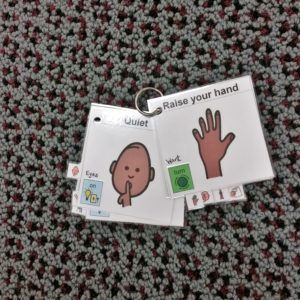
… Encourage staff to start off by modeling (pointing to) a single word for each sentence they say.
… Tweak training methods, presented content and staff support as feedback is received.
… Anticipate at least 3 years before you see your efforts taking hold.
Initial training on CV was targeted with a few school-based “teams.” We specifically highlighted that the CWB is a tool for the teacher to use to teach vocabulary visually and as a tool for the student to use for early expression.
If the tool is not readily available, it cannot be used. Because of this, we made sure to provide several folder-sized and paper-sized CWBs for each teacher and SLP to use with their students right away during each or our early trainings on CV.
During trainings, we gave just enough of the reasons (the “whys”) for staff to get started. We also stressed, that the biggest take-away from the training to just “model” use for students by highlighting a single word on the CWB for each direction or comment a teacher states.
For the few initial teachers and SLPs that seemed to “run with it,” we captured video and pictures. Their excitement and ours were shared with staff at other schools in successive trainings.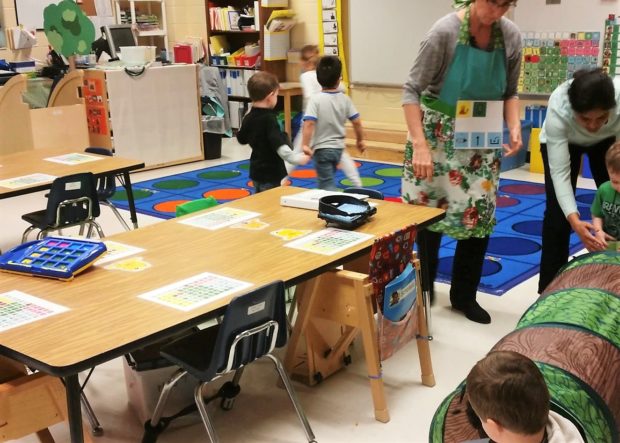
Based on what we saw in various classrooms, new things learned, and general feedback; the trainings we now provide have evolved from primarily CV content, to now also include information relevant to best practices in the communication-focused classroom. More on this later.
The turning point for our programs was around three years of starting. How did we know? We heard from staff in another building that an administrator asked if anyone knew what a Core Word Board was since it was discussed at an IEP meeting. It turned out that the IEP meeting occurred at a school at which we had not completed a formal training. This was incredibly cool to hear!
Every teacher, SLP, and para continuously evolves with support from your inspired few and sometimes from some unexpected others that pick up the torch
Granted, there were indeed missed opportunities getting started. All, however, have contributed to our learning process and have added a fuller perspective on our long-term goals and how to get there.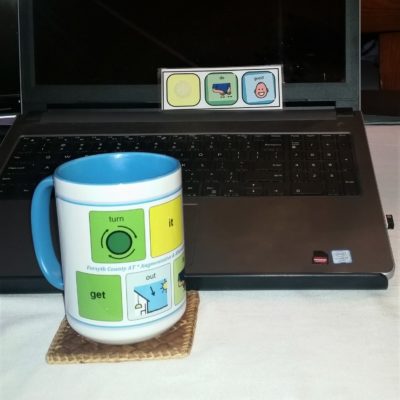
::::::::::::::::::::::::::::::::::::::::::::::::::::::::::::::::::::
Join us again next Thursday as Jennifer continues to share her district’s experience in Part 2 of this post.
Filed under: Featured Posts, PrAACtical Thinking
Tagged With: education, implementation, school
This post was written by Carole Zangari

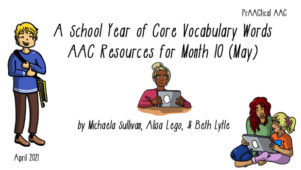
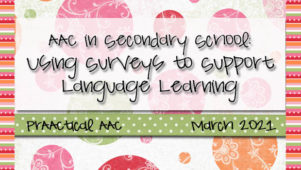
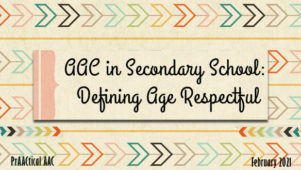
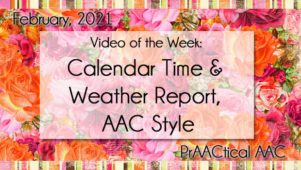
3 Comments
This information is immensely valuable to those of us ‘AAC-core word passionate’ but few. Great training-sharing material. Thank you so very much!
I am looking forward to Part 2. It is great to hear about a District-Wide core vocabulary initiative. I was particularly interested in Jennifer’s comment that the turning point for starting their program came after 3 years.
Kathleen, Thank you for the kind words. We’re still working on it.
Gail, We’re actually finding 3 years is quite consistent for many of the trainings we do; though it can be a bit longer pending various reasons and the amount of follow-up support. The first year is often just increasing awareness/knowledge and getting the materials in place consistently, while staff “think on” or dabble with how the materials/concepts fit into their everyday.
🙂 Jennifer